To paint a car door, the process typically begins by prepping the surface, especially if it’s bare metal or has existing paint that needs attention. An auto painter will assess the job’s scope and quote accordingly, factoring in the cost to paint, which includes the base coat, all necessary layers of paint, and the quality of the paint itself. How much does it cost to repaint a car door at home and in the workshop you can find out here.
After application, a crucial step is wet sanding to ensure a smooth finish. Overall, the cost to paint car doors can vary based on these factors, with quality and detailing playing significant roles in the final price.
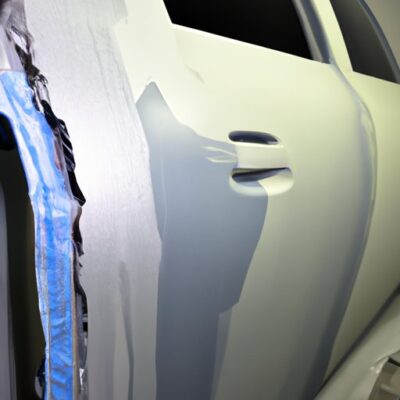
Should I repaint the door myself or take it to a professional?
The question of whether to repaint your car door yourself or take it to a professional is a common one. It hinges on a few key factors: your budget, desired quality, and comfort level with tackling the project.
Cost considerations
Up front, repainting yourself might seem cheaper. You’ll need to buy materials like sandpaper, primer, paint (matched to your car’s code – that label inside the door jamb or owner’s manual is key!), clear coat, and possibly body filler for dents.
DIY vs. professional costs
Professional paint jobs typically range from $500 to $700 for a single car door, depending on factors like location, paint type (metallic paint will cost more), and body shop labor rates.
While DIY saves on labour costs, you’ll need to factor in the cost of tools you might not have, like an air compressor and paint gun (a large capacity spray paint gun might be necessary for a quality finish).
Quality and time commitment
A professional paint job offers a quality unmatched by most DIY attempts. Body shops have the experience, equipment (like a professional painting flow booth), and trained auto painters to ensure a flawless finish, including blending the paint seamlessly with surrounding panels.
They’ll also handle prep work like sanding, applying body filler, and using a clear coat for extra protection.DIY painting a car door requires significant time and meticulous attention to detail.
Tasks like sanding the car door panel with different grits of sandpaper, masking everything off with a paint masker and drop cloths, and applying multiple coats of paint all take time and practice.
Wet sanding between coats requires specific techniques to avoid ruining the new paint job. A professional can typically complete a car door repainted in a few days, while a DIY project might take a week or more.

Can you handle it?
DIY painting requires some experience with tools and paints. Knowing how to use a spray gun properly is essential for a smooth finish. Matching your car’s paint colour perfectly can be tricky, even with the paint code.
And what about unexpected issues? Rust removal or dealing with extensive damage might require the expertise of a professional body shop.
If you’re looking for a high-quality, long-lasting paint job and don’t have experience with car painting, a professional body shop is the way to go. They’ll handle everything from paint matching to the final clear coat, ensuring a flawless finish that blends perfectly.
Even a seemingly simple DIY project like painting a car door can quickly become overwhelming. Weigh your options carefully, considering factors like potential cost savings, quality expectations, and your comfort level with the task.
What materials will I need to paint a car door?
Before diving into repainting your car door, it’s crucial to gather the right materials. Whether you’re aiming for a DIY refresh or a professional-looking finish, having the proper tools on hand makes all the difference.
Prep work essentials
Sandpaper: in various grits (from coarse for initial sanding to fine for smoothing) to remove the old paint.
Drop cloths: protect your surroundings from paint splatter.
Masking tape and masking film: meticulously mask off everything you don’t want automotive painting, including windows, trim, and surrounding panels.
Razor blade: for scraping off any loose paint or debris.
Rust remover: for tackling any rust spots before painting.
Painting materials
High-quality paint: matching your car’s same paint color is key. Look for the paint code sticker inside the driver’s jamb. Consider urethane paint for better durability compared to synthetic enamel paint.
Primer: provides a smooth base for the paint to adhere to.
Clear coat: adds a layer of protection and shine to your fresh paint job.
Body filler: for filling in minor dents or scratches on the door panel before painting.
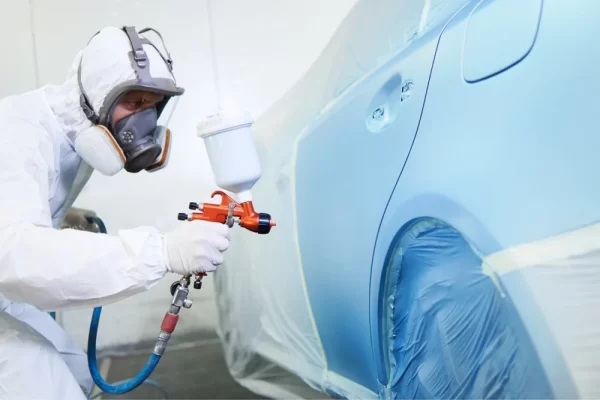
Application tools
Paint sprayer or spray cans: a large-capacity spray gun is ideal for a professional finish. Spray cans offer a more budget-friendly option but require more practice for even application.
Air compressor: provides the pressurized air needed for the automotive jobpaint sprayer to function.
Additional considerations by professional paint job
Professional painter vs. DIY: for a flawless, colour-matched paint job that blends seamlessly, consider using a professional auto body shop. They have the expertise, equipment (like a paint booth), and high-quality paints (including custom paints) to deliver a top-notch finish.
Safety gear: always wear safety glasses, gloves, and a respirator when sanding, painting, or using chemicals like rust remover.
This list provides a general overview. Depending on the condition of your car door painting and your desired outcome (DIY refresh or professional paint job), you might need additional materials.
Consulting with a professional at a body shop or car paint shop can help ensure you have everything for the job.
What steps are involved in repainting a car door?
So, you’ve decided to paint a car door. Whether it’s a pesky scratch or a faded entire job, a fresh coat can breathe new life into your vehicle.
But before you grab the spray paint and dive in, there’s a process to follow for a quality, long-lasting finish.
Previous paint:
- Gather your supplies: you’ll need various grits of sandpaper, masking film, rags, primer, paint, clear coat, and potentially body filler for dents or scratches.
- Clean the vehicle door: thorough cleaning with soap and water removes dirt, grease, and any contaminants that might affect the paint adhesion.
- Sanding the old paint: using sandpaper, meticulously sand the entire door panel. Start with a coarse grit for the initial removal of the paint and progress to finer grits for a smooth finish.
- Addressing imperfections: for dents or scratches, apply body filler according to the manufacturer’s instructions. Once dry, sand the filled areas smoothly.
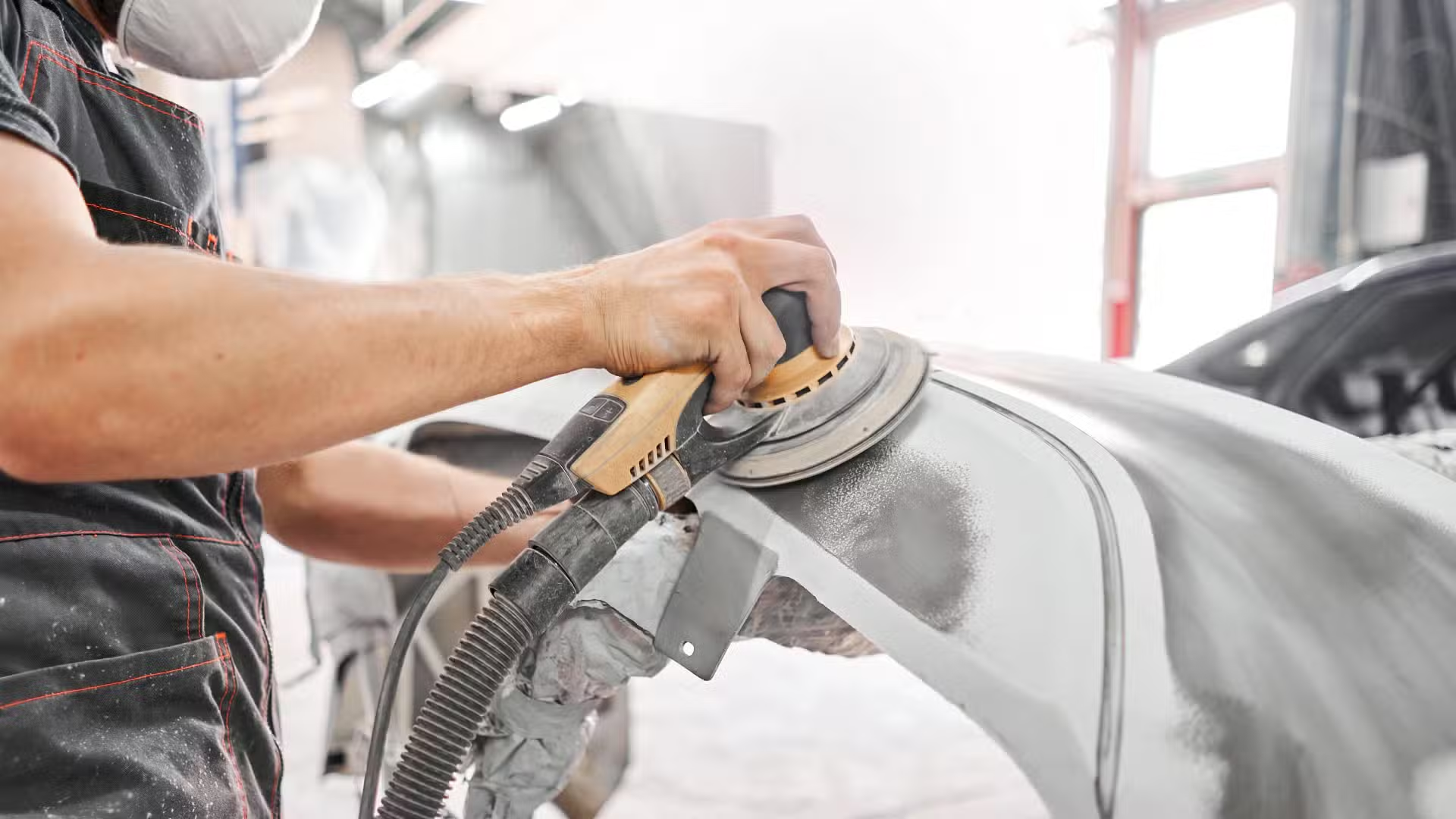
Masking up for perfection:
- Masking magic: this is crucial to prevent overspray and protect surrounding areas. Use tape and film to meticulously mask off windows, trim, and any other parts you don’t want painted.
- Drop cloth defence: lay down drop cloths to catch any paint-quality drips or spills.
Painting process:
- Primetime: apply a coat of high-quality primer to the sanded door. Primer provides a smooth base for the paint to adhere to and helps ensure even coverage.
- Wet sanding: for a flawless finish, lightly sand the primer coat with fine-grit sandpaper after it dries. Wipe away any dust with a damp cloth.
- Painting the door: here comes the fun part! Apply multiple thin coats of the matched paint using a paint sprayer or spray cans. Allow each coat to dry completely before applying the next.
- Clear coat: for extra protection and shine, apply a clear coat after the final coat of paint has fully cured.
The final touches:
- Careful removal: once the paint is completely dry, slowly and carefully peel off the tape and film. Use a razor blade to remove any stubborn tape residue.
- Admire your work: step back and appreciate your freshly car door painted!
Considering a professional?
While painting a car door can be a rewarding DIY project, it requires time, meticulous attention to detail, and the right tools. If you’re looking for a flawless, long-lasting finish, consider getting a quote from a professional shop.
They have the expertise, equipment (like a paint booth), and high-quality paints to deliver a top-notch paint job, including blending the paint seamlessly with surrounding panels.
How long will it take to paint a car door?
The time it takes to repaint a truck door can vary significantly, ranging from a quick DIY refresh to a multi-day project by a professional. Here’s a breakdown of the factors influencing the timeframe:
DIY time factors
DIY expertise: a seasoned DIYer will naturally work faster than a beginner. Expect to spend more time if you’re new to car painting.
Prep work intensity: extensive sanding, filling dents, and removing loose paint add significant time. A heavily damaged door will require more prep work.
Painting technique: using a large-capacity paint sprayer can expedite the process compared to spray cans, which often require more coats for even coverage.
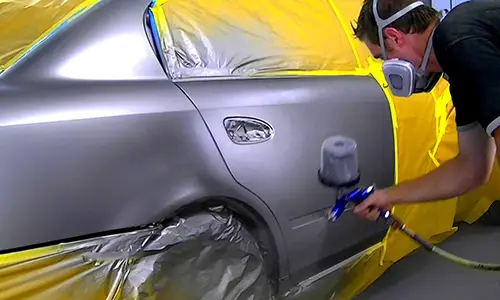
Considering these factors, a DIY car door painted could take automotive paint :
- A single day: for a quick refresh by a seasoned DIYer using an automotive paint sprayer and minimal prep work.
- Up to a week: for a more thorough job involving multiple paint coats, wet sanding between coats, and meticulous prep work.
The shop advantage:
Professional body shops offer a significant speed advantage due to their experience and equipment:
- Streamlined process: body shops have a well-honed truck door repainting process, allowing them to move efficiently through each stage.
- Paint booths: dedicated paint booths control dust and temperature, ensuring optimal drying times and a flawless finish.
- Professional expertise: auto painters know exactly how much sanding is needed, how many coats to apply, and how to achieve a perfect colour match, saving time on trial and error.
A shop can typically repaint a truck door in:
- A few days: this is the standard timeframe for most body shops.
- Same Day: some shops offer same-day service for minor repairs on normal cars.
Finding your speed:
- DIY for savings: if you’re on a tight budget and have the time and patience, a DIY approach can save money. However, invest in proper tools and automotive paint for a decent result.
- Professional quality: for a guaranteed, long-lasting finish that blends seamlessly with surrounding panels, a shop is the way to go. While it might cost more upfront, you’ll get a quality paint job done right the first time.
Cost to paint a car door
The cost of a car door painting can vary depending on whether you take the DIY route or enlist the help of a professional. Here’s a breakdown of the cost factors for each approach:
DIY dollar decisions
Materials: you’ll need sandpaper, primer, paint (paint color code inside, paint match to vehicle door), clear coat, wet sand, high-quality base coat, and possibly body filler. Paint like urethane paint will cost more than synthetic enamel but offer better durability.
Tools: consider the cost of a sprayer or spray cans. You might also need a compressor for the sprayer.
DIY can save on labor costs
Hidden costs: unexpected factors like needing more paint or encountering extensive damage can add to the overall cost.
Time investment: DIY takes significant time and effort.
The estimated cost for a DIY truck door painted could range from:
- $50 (for a very basic refresh using spray cans and minimal materials)
- to $200 (for a more thorough job with higher-quality materials).
Going pro
Labour costs: shop labour rates vary by location, but expect to pay a significant portion of the total cost for their expertise.
Materials: shops typically use high-quality paints and have access to professional equipment, which might be reflected in the cost.
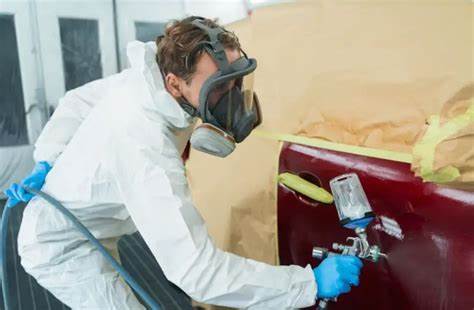
Additional considerations
Custom paint job: if you want a custom paint job for a car door that strays from your car’s original colour, expect to pay more for the additional automotive paint sprayer and potentially more labour time.
Insurance coverage: in some cases, your insurance company might cover repainting a car door if the damage is due to a covered event. However, deductibles and coverage limitations apply.
Finding the right price
Get quotes: always get quotes from several shops before making a decision. This allows you to compare prices and services offered.
DIY vs. pro: weigh the cost savings of DIY against the guaranteed quality and time efficiency of a professional job.
Conclusion about the cost to paint truck door
When considering the cost of painting car doors, it’s essential to account for all aspects of the process. This includes the expense of all the paint layers, the quality of the paint used, and the meticulous wet sanding required for a flawless finish.
Each of these variables contributes to the ultimate taking a toll, guaranteeing a professionally painted car entryway that meets both tasteful and toughness measures.

Matthew Edward is a professional painter who loves to paint and wants to share useful tips and tricks which he had learned in many years of experience in painting. He also used many products that can be used for painting he has tried and tested each and every product to give an unbias opinion about it in his review. This blog is very useful for those newbies who want to learn painting without making mistakes.






